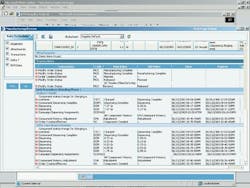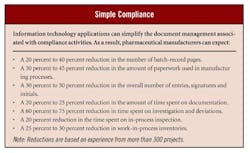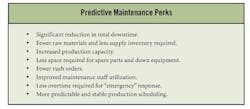Integration Pay$
Sensors, transmitters, regulators, valves and myriad other equipment required for pharmaceutical manufacturing can combine to create a minefield of surprises for process engineers and operators. Fortunately, technology advances now allow this equipment to provide intelligent data that can be tracked, analyzed, reported and archived electronically.
The availability of equipment and device information related to electrical connection, status (clean, dirty, in repair, etc.) and usage ," in real-time and online ," enables production planners and schedulers to maximize production while running the process and equipment at an optimal level.
In today's heavily regulated Good Manufacturing Practice (GMP) production environment, facilities that run their processes and equipment at an optimal level reduce:
Loss of revenue resulting from prod-uct unavailability. Manufacturers could lose thousands of dollars each day the product is not available.
Loss of expensive raw materials and supplies. If production is shut down because of equipment-related issues, raw material degradation or expira-tion could become an issue.
Customer dissatisfaction. If a manu-facturer consistently misses delivery dates, customers are sure to become disenchanted.
The possibility of losing business to competitors. If a product is not available, some customers will be forced to seek an alternative.
Shortened product shelf life. The shelf life of drugs is critical. If a product is delayed as a result of equipment-related deviations or out-of-specification situations, then shelf life is condensed even further.
Many pharmaceutical manufacturers wish to accelerate drug production, but find it difficult. The companies still must adhere to regulations issued by the U.S. Food and Drug Administration (FDA), the U.S. Department of Agriculture, the U.S. Environmental Protection Agency and many other government agencies. The Code of Federal Regulations that governs many aspects of pharmaceutical production requires companies to keep equipment maintenance-related data records, activity logs and reports with respect to maintenance activities performed, equipment condition status before and after use, dates for events performed and equipment control parameters.
Noncompliance with regulations has become an increasingly costly proposition. In 2001, FDA collected approximately $500 million under consent decrees with manufacturing companies, up from just $100 million in 1999. Many of FDA's actions related to GMP violations. In 2003, the total fines could approach a billion dollars.
Manufacturers, therefore, need information and solutions that address their need for fast production-cycle time and sustained regulatory compliance. A proactive preventive maintenance and asset management program ," one that is linked closely to and integrated with production schedules and recipe execution ," can help.
The key to creating this link is Extensible Mark-Up Language (XML). XML is a specification originating from the World Wide Web Consortium. It was developed to provide programmers and Web application designers with a common format to describe and facilitate the exchange of data between application software programs.
XML "explains" the way data are formatted and communicated between software applications and the computers running the applications. When data are formatted in XML, the applications requiring those data do not require the creation and maintenance of standardized application programming interfaces (APIs) over the lifecycle of use. In addition, XML allows facilities to use more programming tags to format, structure and search for information within an application. For example, "text" is one of the few data formats universally supported on computer platforms even when the character sets on the platforms vary with special characters.
XML also promotes data simplicity. It organizes data while keeping it in a user-readable form.
Using XML, facilities can access, combine and reuse data without re-entering them, and can tag or label data elements in formats that different application software programs can recognize. Facilities then can exchange data among equipment, controller and software more easily.
XML promotes data simplicity
When data are formatted in XML, the applications requiring those data do not require the creation and maintenance of standardized application programming interfaces (APIs).
Predict problems
Pharmaceutical manufacturers can speed their time to market by eliminating as many process stoppages as possible. Information technology can be an important tool.
Typically, preventive maintenance programs monitor equipment continuously and produce work orders in real-time or on an as-needed basis. For example, if a piece of equipment begins to operate at an unacceptable level, a predictive maintenance program will issue an alert, and a technician will respond before an out-of-specification occurrence causes an equipment stoppage. The equipment stoppage can be even more serious if a lack of available spare parts delays the repair, adjustment or calibration.
By linking predictive and preventive maintenance programs to recipe execution, pharmaceutical plants can avoid equipment problems and process stoppages. Instead of reacting to equipment failures as they occur, operators, process engineers and production planners would be able to predict when equipment will begin to develop a problem and could take proactive measures to bring the equipment or device back to specification ," without being forced to scrap the current production batch.
Predictive maintenance programs involve many elements, but device and equipment data are essential. Plants can collect equipment performance data using a variety of devices.
In some cases, an intelligent device provides data automatically. More often, however, an operator or maintenance engineer records and reports data using a handheld data terminal with a barcode scanner to assist with equipment identification. The technician manually enters data about the device or equipment, and he or she can analyze these data and combine them with other information for trend analysis and optimal use determination.
Plant personnel can plot trends using corrective and preventive action (CAPA) software to determine the cause or causes of equipment problems. Equipment experts subsequently can determine a strategy for correcting or preventing the problem.
Web-based access to the asset management information can further optimize equipment availability. For instance, if a common piece of equipment is being used in multiple plant locations, Web-based access to the equipment database can speed plant personnel's access to regularly observed conditions or problems and hasten preventive or corrective action. Work orders can be sent automatically to technicians when maintenance is required ," anytime, anyplace and anywhere. In essence, technicians do not have to remember to access each stand-alone system separately. Instead, the Web-based system alerts users when action is required. Work stoppages resulting from equipment failure become far less common.
By linking the preventive maintenance system to the asset management system via the Web, plants are prepared for unexpected equipment problems. If an operator or maintenance technician obtains an out-of-specification reading from a piece of equipment or a device, he or she can relay the problem to engineering maintenance via the plant's intranet. Engineering personnel then access the device, view the status of the equipment and decide whether or not batch production should continue. Without Web-enabled connectivity, the operator would have to wait for a technician to inspect the equipment physically.
Proactive asset management also helps reduce labor expenses. A maintenance technician need not go from device to device to check operating status at regular intervals. Instead, the technician need only access the intelligent devices requiring attention. The system, in essence, performs all of the monitoring.
One manufacturer recently reduced its preventive maintenance workload dramatically by capturing information about devices and equipment online and in real time.
Since the facility installed a real-time data collection and reporting system on its devices and equipment, it now plans and performs work for only the devices and/or equipment with deteriorating performance parameters. As a result, work that was focused previously on data collection and reporting now is channeled into actual replacement and repair activities before the equipment or process goes out of service or out of specification.
When plant personnel are notified of an equipment or device problem, they search a database for a specific tag number to obtain basic information such as specifications, adjustments and calibration parameters. They then interrogate the device or equipment online to assess its operating condition and determine whether to replace it or repair it ," and when.
Personnel not only troubleshoot equipment and devices from the safety and convenience of the maintenance shop, but also document their activities automatically.
Streamline compliance
Fewer unplanned work stoppages mean more product is released in a timely manner. However, to get products out the door more efficiently, pharmaceutical manufacturers also must streamline the quality review process. During this step of production operations, predictive asset management programs can be invaluable in preventing release delays resulting from equipment specification deviations.
In pharmaceutical enterprises, partial evidence of regulatory compliance is achieved through maintenance of records required by Subpart J (records and report) in FDA's Current Good Manufacturing Practices (cGMPs). Subpart J covers equipment cleaning and use logs; component and labeling records; master production and control records; batch production and control records (together with their review); laboratory records; distribution records; and complaint files. Facilities must document recipe and process compliance in all of these areas, as well as in areas not specifically called out by Subpart J, but maintained as evidence of compliance with other sections of the regulations. These related sections include personnel training records; process and system validation records and reports; standard operating procedures; analytical methods; and material specifications.
The challenge is to access and report the combination of all data to maintain compliance with regulations. Typically, facilities must maintain written process control procedures, records and related documents for inspection. The quality assurance department must review a representation of these records ," the batch record ," before the product is released or distributed. To put together a batch record, plant personnel might be required to piece together a couple of pages ," or to assemble a document that is hundreds or thousands of pages long. Electronic data collection, reporting and presentation can save thousands of dollars annually and reduce time spent manually on data collection and review.
An electronic version of this information also is very helpful for search and retrieval purposes because the batch record includes all information and records used to control batch execution. An electronic batch record then can be reviewed and released faster.
Naturally, fewer equipment-related work stoppages translate into easier compliance with recipes and regulations. If equipment is functioning at optimal levels, less documentation about equipment failures and resolutions is needed.
Real-time data collection and reporting capabilities can improve product quality and reduce compliance time by:
Replacing labor-intensive, time-consuming manual processes for reporting formation, including manual copying, distribution and maintenance of procedures and equipment log books.
Maintaining data fidelity and control.
Providing data integrity, security and control with electronic signature and record rules.
Supplying meta-tag data definitions.
Managing electronic review, approval, publishing and change-control processes.
The reduction of transcription errors pays off in reduced time spent on quality assurance activities. By using such systems, some manufacturers have reduced the time spent on deviation investigations by almost 75 percent.
Connect systems
Although the benefits of using an integrated asset management system based on predictive maintenance methods are numerous, the beauty of the system is the tracking and control reporting, which can reduce abandoned batches dramatically.
By using an XML-based asset management system, manufacturers can integrate and reuse data elements easily with different applications. Thus, an asset management system and equipment tracking and calibration applications all can reside on the same server, and users can access the applications via a Web browser.
A zero-client implementation eliminates the cost of loading and maintaining the application software onto each client device. In a zero-client implement- ation, no application software other than the actual Web browser is installed on the client device. The zero-client application design provides tremendous cost benefits to pharmaceutical manufacturers in deployment, scalability, maintenance and validation.
The value of these systems is enhanced further when the systems are integrated with existing software applications such as enterprise resource planning, laboratory information management and electronic document management systems.
Although the benefits of integration are clear, the job often proved to be too cumbersome and expensive in the past. Proprietary data file formats required customized application program interfaces, which were difficult to maintain and keep validated. By using an XML file format, servers now can exchange information more easily with one another.
You can do it
For years, integrated technology has been heralded as a worthwhile ," but difficult to attain ," pursuit. With the development of Web-based systems technology, the possibility of integrated data, systems and information now is within the grasp of virtually all pharmaceutical manufacturers. An integrated system is just the prescription for an industry that stays competitive by bringing products to market in a timely and efficient manner.
Cochran is a vice president with Decision Management International (DMI), Bradenton, Fla. DMI is a provider of software and implementation services for FDA-regulated manufacturers. He can be reached at [email protected].



